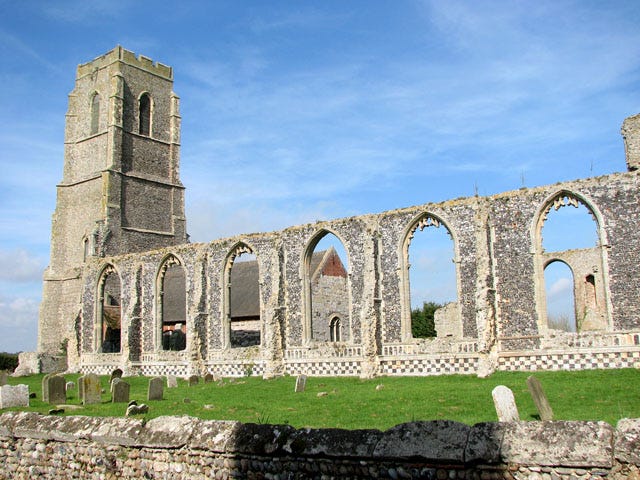Spectacular. The ruins of St Andrews Church in Covehithe (Shutterstock)
This must have been a magnificent Church in its time.
I know, I know. If you’re a regular reader of this blog (and thankyou so much if you are, I appreciate your patronage tremendously) you’ll know two of my weaknesses are Churches and ruined buildings.
Put the two of them together and its catnip to me as I’ll immediately go all silly.
As I am prone to do with this one at Covehithe on the Suffolk coast. It genuinely must have been ‘take your breath away’ territory at its peak.
Mind you, I think that, even in it’s structural death throes, Covehithe is still capable of sending a delicious chill running down your spine.
The ruins here remind me of the equally dramatic St Margaret’s Church in Cley on Sea on the Norfolk coast.
Had it, I am sure, stood in one of Europe’s great Cities, Florence for example, Paris or Rome, I am convinced it would be as much a part of the ‘must see’ sights for those places as any other that they may contain.
Yet, there it sits, alone and exposed in a small Norfolk village, a carelessly misplaced Cathedral in splendid isolation, its derelict north and south transepts a sign of how prohibitively expensive a large church was for a small community.
St Margaret’s Church in Cley. It wouldn’t look out of place in Florence or Paris (J Hannan-Briggs/geograph)
Because the grim reality was that if any Church, started to fall into a state of disrepair and its tiny band of worshippers had no means by which they could afford the necessary reparations, then things were just left to get steadily worse and worse until only ruins stood where there had once been walls and worship.
St Margaret’s is a little battered about the edges.
Yet she has prevailed.
Sadly for the grandiose Church that once stood in equal majesty in Covehithe, St Andrews would, ultimately, meet a much more unfortunate fate.
Covehithe. An ecclesiastical extravaganza. Note the tiny ‘new’ church sat in the gnarled nest. (Evelyn Simak/geograph)
The dereliction of St Andrews dates from 1672 which was barely two hundred years after she was first built. This did not solely come about through violence or riot, nor discontent or dissolution.
Its fall to rack and ruin was simply down to the fact that the continuing financial upkeep of such a great Church was too much for a tiny village to manage especially at a time when public worship was regarded as being more about quiet devotion and public modesty rather than ostentatious displays of wealth and power.
A desperate Parish made it clear that it could not afford to manage such a lavish building. Their pleas were heard and they were given permission to remove its roof and build a much smaller and more humble Church in place of the gargantuan original. It nestles, suitably meek and mild within the ruins today, the only remnants of its predecessor being the lofty tower and some of the vast original walling.
Covehithe was not totally exempt from deliberate vandalism however.
Before the roof was finally and irrevocably removed, St Andrews was paid a visit by a William Dowsing. He was, as far as medieval Churches were concerned, as much a nemesis as Richard Beeching was later to become for the regions railways.
Dowsing was a fervent Puritan and iconoclast; that is, one who holds the social belief that it was vitally important to destroy religious icons, statues, monuments and other images.
St Andrews, with around 200 such images beautifully created and revered in its stained glass didn’t stand a chance against his destructive leanings. He would, furthermore, have been given every encouragement and assistance in destroying them by the Churchwardens of St Andrews who would undoubtedly have been Puritans themselves.
A liturgical tragedy.
Covehithe viewed from the cliff edge. Its fate is assured. (Roger Jones/geograph)
The present day ruins at Covehithe are under the care of the Churches Conservation Trust. Their cause and work in preserving such sites is to be admired but even they will not be able to prevent the ultimate fate of the site which will, one day, be to fall prey to the North Sea as ongoing erosion steadily and inevitably wears away at the nearby coastal fringes.
Meaning that, one day, Covehithe will one day inexorably slither and slide into the unforgiving maw of the North Sea and become, in an instant, as much a coastal legend as the Church at nearby Dunwich eventually became.







